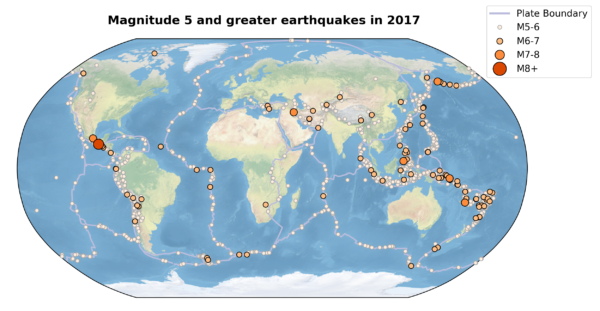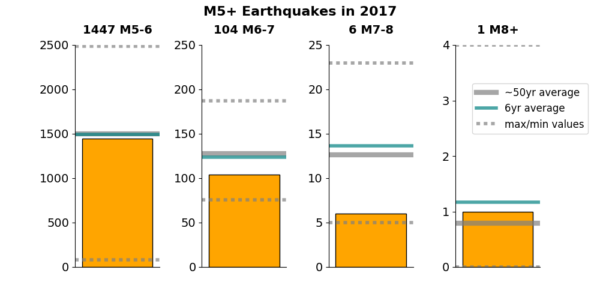Plenty of natural disasters hit the news in 2017, but most of the headlines were hogged by disasters linked to extreme weather, such as Hurricane Harvey. Nonetheless, in the background the Earth’s tectonic plates continued bumping and grinding against each other, producing 1,558 earthquakes of magnitude 5 or greater over the past 12 months. As well as a map of individual locations, I’ve also produced a global seismic ‘heat map’, scaled to represented the total energy release in each grid square.

Global Map of 2016 earthquakes, according to the USGS database.

Heat Map of global seismic activity, scaled to total moment release from all M5+ earthquakes in each 5º grid square
Unlike last year, we did see a magnitude 8 earthquake this year, in the form of a M8.2 in the subducting slab off the coast of Mexico. The logarithmic relationship between magnitude and energy release – one unit on the magnitude scale equals 32 times as much energy – means this single earthquake shows up quite clearly as the darkest square on the heat map. A further six earthquakes – about one third of 1% – were between magnitude 7 and 8, and 104 – about 7% – were between magnitude 6 and 7. The remaining 93% were between magnitude 5 and 6.

Number of earthquakes in different magnitude ranges in 2017, compared to longer term averages and ranges.
If we compare these tallies to the instrumental record of seismic activity since the mid 20th century, 2017 meets expectations at the low and high ends: based on the last 50 years, we expect around 1500 magnitude 5-6 earthquakes in an average year, and maybe one event larger than magnitude 8. In the middle, the numbers of M6-7 and particularly M7-8 earthquakes last year were lower than the 50-year average. Not ‘lower’ in the sense that they’re outside the observed variability in the instrumental record, but lower than they’ve been for some time: 1998 was the last time we had this few M6-7 quakes (109 vs 104), and 1982 was the last time it was lower (83 M6-7 quakes, at the end of a decade of fairly quiet years); 2017 also saw the lowest number of M7-8 (6) since 1980. In other words, it hasn’t been this quiet since I was a wee lad.

2017 earthquake frequency compared to the instrumental record since 1950 (note that M5-6 events are largely missing from the catalogue prior to the 1970s).
One surprising observation is the lack of large (M6-7) aftershocks of the M8.2 Mexico quake in September. The response was strangely muted: the largest aftershocks are mainly M5-6, with a M6.1 right at the edge of the aftershock cloud. The fact that it was an extensional event due to bending within the plate, rather than occurring on the subduction thrust, might explain this. There was a possibly linked M7 shock: an M7.1 close to Mexico city, that was also the year’s second deadliest behind a M7.3 on the Iran/Iraq border in November. Occurring 650 km away and 12 days later, it was too far away to be affected by permanent stress changes in the crust around the M8.2, and too late to be triggered by the transient stresses associated with passing seismic waves. The possible mechanisms of longer-term triggering at a distance are still poorly understood, but the timing is certainly suspicious.
Interest in decadal trends in global earthquake activity has been boosted recently by a newly published study that suggests a link between changes in the Earth’s rotation rate and the frequency of large earthquakes. As the lead author explains, we’re not talking about generating earthquakes that wouldn’t have happened anyway. Instead a small nudge, in the form of a slight deceleration in the Earth’s rotation that imparts some additional stress on the rigid lithosphere*, causes faults that are already poised to fail to rupture a little bit earlier than perhaps they would have otherwise. The mechanism is plausible: the daring part is that the authors have made a prediction that a recent slowing of the Earth’s spin is going to cause a spike in M7 or greater earthquakes over the next five years. If anything, this year’s relative calm makes monitoring that hypothesis a bit more difficult, because more than 7 earthquakes a year above magnitude 7 is a low bar that we’d generally expect to be exceeded even in the absence of any external factor. The question is whether we’ll see an increase significantly above the long-term average of around 15 events a year.
Definitely something to keep an eye on in the next year or five. I have questioned its usefulness for seismic hazard assessment, since we are talking about a relatively small change in a global signal: others have argued that in edge cases (such as a fault at the old end of its known recurrence interval) it may be relevant, and that there are in fact some interested parties with global exposure.
NZ seismologists seem skeptical about proposed link between Earth’s rotation rate and large earthquake frequency.
Even if true, scientifically interesting, but not usefully predictive. https://t.co/KtXxURkQXH
— Chris Rowan (@Allochthonous) November 20, 2017
With my family living in a subduction zone, I would rather know the slight possibility and have them be more alert and EQ-ready (scaremongering not included in this comment).
— Dr Janine Krippner (@janinekrippner) November 20, 2017
What is true that as we have seen again this year, bigger does not necessarily mean badder when it comes to earthquakes: the two deadliest earthquakes this year were both low magnitude 7. Any magnitude 7 earthquake represents a substantial hazard if it happens in the wrong place.
*Because the ‘solid’ Earth beneath the lithosphere is ductile and can flow in response to stresses, the Earth’s rotation causes it to bulge at the equator. The size of this bulge depends on the rotation rate; reduce the rotation rate and the Earth will (slowly) flow into a more spherical shape. The lithosphere is cold and rigid, so accumulates stress instead as the bulge shrinks beneath it.



Nice plan for content warnings on Mastodon and the Fediverse. Now you need a Mastodon/Fediverse button on this blog.